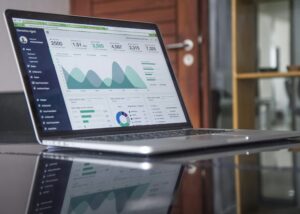Est. reading time: 5 minutes

Social media analytics in marketing helps in making informed and data-driven decisions and improving marketing performance.
While social media is a good leverage, businesses must put out relevant content that will attract people’s attention. Doing this can be quite tricky, but with the help of the right information and analytics tools, it is possible. This is where social media analytics comes in.
We will give detailed information on social media analytics and how it can be of use to your marketing goals.
What does Social Media Analytics Mean?
Over 5 billion users worldwide use social media, making it a suitable place for businesses to connect with their potential audience and customers. To do this, social media analytics can be helpful.
Social media analytics is all about gathering, analysing, and interpreting data from social media platforms. This helps to understand what’s working, what’s not, and how to do better.
You can think of it as getting insights about your likes, shares, views, clicks, and comments to figure out what the interests of your audience are.
Businesses that value customer experience and feedback usually note customers’ reviews to understand their pain points and views about the business.
Social media analytics in this case can help businesses improve their customer’s experiences and improve business performance. The insights given by these analytics tools can help in making decisions that will help their audience.
The Right Social Media Metrics to Lookout For
Knowing what to look out for is important when it comes to social media analytics. Monitoring different types of social media metrics on different channels can provide crucial insights and guide your strategy.
Here are the key metrics to look out for.
Audience Evaluation
The goal of social media analytics is to help in knowing the right audience and meeting their needs. Audience analysis is all about examining various factors such as demographics, language, location, preferences, and interests.
Aside from demographics, there are other social media metrics you might want to consider. Some of these metrics are the customer’s behaviour towards your product, how often they purchase, and what social media platforms they use more.
As regards competition, you must know what social media sites, websites, blogs, or magazines they frequent. Do they prefer getting information via email, or do they engage more through other social media channels?
Competitors Analysis
When it comes to analysing your competitors, it is important to check out their performance on social media. How many followers do they have? How often do they put out content? What is their engagement rate? How many people interact with each of their posts?
When you’ve done this, you should then compare it with your statistics to see where you stand and set more realistic media goals. It is also important that you stand out. If you need help gathering all your social media data in one place and measuring it across different networks, Kian Consult is a professional agency to help you with that.
Performance Evaluation
Measuring the overall performance of your social media platforms is important in seeing how well you’re doing. It also helps to know what area you need to improve.
Performance evaluation helps digital marketers and businesses make decisions based on real data. It shows why a marketing campaign succeeded or failed. Once you understand what didn’t work, you can change your social media strategy to make it better.
Here are some social media metrics for measuring performance:
- Views
- Likes
- Clicks
- Comments
- Shares
- Reach
- Impression
- Increase in followers
- Sales
Top Social Media Analytics Tools
While it is important to know what social media analytics is, it is more important you get familiar with the tools. This will help in choosing the right one for your business.
Social media analytics are digital tools that enable brands and businesses to collect, sort, and interpret large amounts of data from social media platforms.
Without these tools, it would have been difficult or probably impossible to get insights into social media platforms. This would have been a huge barrier to communicating effectively to your audience.
Lots of marketers are missing out on crucial analytics tools for reaching their top media goals. The right analytics tool should be easy to use, clear, and help streamline your processes, so that your marketing can grow and improve.
Besides daily tracking and analysis, it should also give you a clear picture of your social media performance, showing where you can capitalize on opportunities and where you might need to adjust your social media strategy to avoid problems.
Here are the top 5 social media analytics tools:
- Google Analytics
- Hoot suite
- Buffer
- Tailwind
- Sprout social
How to Collect and Interpret Data from Social Media Analytics to Develop
Data collection, sorting, and interpretation are important in making decisions that will yield positive marketing results. You don’t just use social media to push out content, you must do everything based on the data you have for effective results.
Collecting data is where you gather all the statistics from all social media platforms, such as Instagram, Facebook, Twitter, LinkedIn, and others. This data can involve the number of people who liked your content, the number of shares, clicks, views you got, the number of comments, the number of new followers, and so on.
To make things easier, you can collect your data and put them in a spreadsheet. Ensure that you use separate spreadsheets for each social media platform you are analysing. You can make use of applications like Google sheets and Microsoft Excel.
Collating your data into spreadsheets will prevent confusion and help you have your data in a place. Once you’ve collated your data for a month or more, depending on how far you want to track your performance. After doing this, you can try to make sense of all the data you’ve collated.
It’s no news that doing this is a daunting task; this is why we at Kian Consult are ready to help you make things easier.
Also, as you review each month’s metrics, from the figures you are getting, you can tell if you’re doing well or not. You can add a grade column for each metric to your spreadsheet to help you note things down.
Create a list of metrics that are either declining or remaining stagnant, and think about the actions you can take to enhance these areas.
Developing Data-driven Content Strategy
Now that you have an understanding of how to collect and interpret data from social media channels, you must also understand that you didn’t just collect them for fun, you want to reach a marketing goal with it.
Data-driven content in marketing involves using insights obtained from social media analysis to make informed decisions about your business in relation to social media.
For instance, if post impressions are consistently low, consider increasing the budget for sponsored posts. If you’re seeing a steady drop in comments, try incorporating content that will motivate your audience to engage your posts, or even share with their friends to boost follower numbers. If you sell products or services, and you’re not getting much sales, focus on creating content on how your product or service can be of help to them.
Final Thoughts
In summary, mastering social media analytics is essential for optimizing your marketing strategy and achieving better results. By carefully monitoring various types of analytics, you gain valuable insights and focus on data-driven decisions that can guide your content creation, audience engagement, and overall strategy.


Nice one! Found this information very enlightening. Thank you very much.